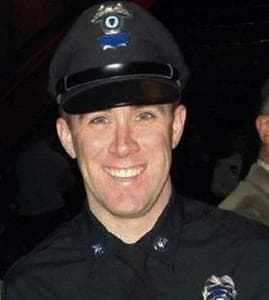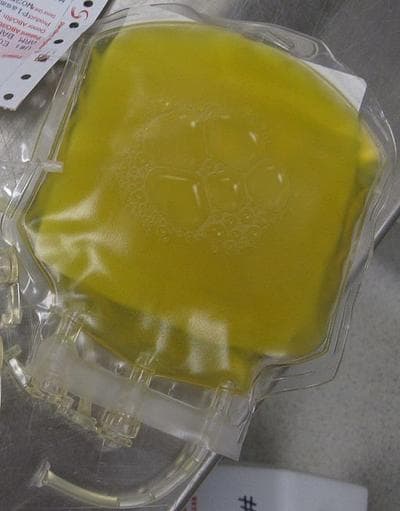Advertisement
Medical Yarn: How Did Boston Injured Survive Massive Blood Loss?

And the officer, Richard Donohue, was not alone in either his heavy blood loss or his positive prognosis.
The Boston Marathon bombs left the finish-line area splattered and pooled with blood, yet, says James Hooley, chief of Boston Emergency Medical Services, "Anybody who arrived alive in a Boston hospital is alive today."
Bombing suspect Dzhokhar Tsarnaev had reportedly been bleeding for many hours when he was finally found in a backyard boat, yet he recovered so fast that he has already been transferred from the hospital to prison.
This is not what happens in the movies. People who "bleed out" fade quickly, gasp a few last words, and then a sideward flop of the head signals that they have expired.
But in real life, trauma specialists say that among many other contributing factors to the success of Boston's medical response to the bombings, the field has made important advances recently in treating patients with massive blood loss.
In fact, some of that progress makes quite a medical yarn, of how medicine can correct itself in the face of important new evidence.
'We collected several units of this fresh whole blood, gave it to our wounded, and it was like magic.'
Dr. Daniel Dante Yeh, a trauma surgeon at Massachusetts General Hospital who helped treat the bombing victims, said that all his patients had lost a lot of blood.
“I remember, at the early stage of my training, how they would have gotten flooded with salt water and subsequently stayed in the ICU for weeks," he said. "Although salt solutions can be lifesaving when there's nothing else available, we've come to appreciate the harm they can cause when given in excess. The pendulum has swung back towards moderation and, in turn, our critically injured patients are doing better than ever."
Salt water? Harm? Dr. Yeh explains the back-story of what he calls a sort of “re-revolution” in blood transfusions:
Up until about 50 years ago, he said, patients would be transfused with whole blood. Then, as blood banking developed, bankers would “fractionate” the blood — something like processing whole milk to divide it into heavy cream, skim milk and other components.
Milk's fatty cream might be compared to the plasma in blood, which contains proteins that help with clotting. The skim or 1% milk can be compared to red blood cells, which carry oxygen. Blood also contains platelets, for clotting.

The blood bankers realized that not all patients needed all the components of blood, Dr. Yeh said, and calculated that it would be more efficient to give mainly packed red blood cells, with far less of the plasma and platelets.
That practice "creeped in" to trauma care without real evidence, he said, and became standard — giving patients mainly the "skim milk" of blood, with some added plasma and platelets for every six or ten units of red blood.
Often, the treatment also included "crystalloid solutions - which is basically salt water," to add volume, "keep the pipes full," and raise blood pressure.
But in the last few years, military experience provided a game-changing corrective. Joe Blansfield, trauma program coordinator at Boston Medical Center and formerly chief nurse at a combat support hospital in Iraq, describes the view from his own time in the military:
"We had several experiences where we'd get a mass casualty event, multiple patients, a lot of need for blood, and we'd literally exhaust our blood bank and have no re-supply. You'd call headquarters and they'd say, 'We'll send you a helicopter with more blood, and we'll be there tomorrow.' But you'd need the blood today.
"So we'd line up all the soldiers and say, 'Who's got O negative blood?' They were happy to donate, and they didn't ask who the blood was for, and we collected several units of this fresh whole blood, gave it to our wounded, and it was like magic. Their coagulopathies would reverse, their respiratory problems would improve in a day or so, and it was really impressive. We said, 'Well, this might be something to pursue,' and we are now looking at this 'damage control resuscitation' very seriously."
Such observations from the battlefield drew little attention until they accumulated rapidly in the wars in Iraq and Afghanistan, Dr. Yeh said. "When you have hundreds of patients accumulated and you present data, you have to stand up and take notice," he said.
Researchers launched broad studies to observe more patients, he said, and the evidence is firm and still growing that damage control resuscitation, this new recipe closer to blood's natural composition, "is the way to go." And it is the practice that was used on the marathon patients, he said.
'The blood can look like Koolaid, it's so diluted and thin — like watery milk.'
Part of the damage-control technique is to minimize the use of salt water, Dr. Yeh said, because it appears to dilute the blood so heavily that it hinders the clotting proteins. The blood can "look like Koolaid, it's so diluted and thin — like watery milk. And even if you've sutured the vessel and done everything to stop the bleeding, the patients are oozing from everywhere, from the IV sites and their eyeballs, they can't clot their own blood."
Along with the damage control technique, Dr. Yeh also credited the high survival rate of marathon patients to the use of tourniquets — and that, too, he said, involved a corrective.
"Again, this is something we learned from recent military experience in the Middle East and Afghanistan," he said. Fifteen or so years ago, tourniquets were viewed with deep skepticism, and concerns were high that they were dangerously overused and misapplied.
Then the lessons rolled in from the many lower-extremity wounds left by low-blowing explosives — that in fact, "the rumors that tourniquets are bad are not true, and they're actually life-saving."
So in the emergency response to the marathon bombings, all the medical teams were savvy enough to use tourniquets well, Dr. Yeh said, "and that's why nobody bled out by the time they got to the hospital."
The success of the Boston medical response can be seen as the culmination of many years of research carefully applied to clinical practice, said Dr. Alfred Sacchetti, spokesman for the American College of Emergency Physicians.

Emergency medicine as a speciality has developed rapidly as a field over the last three or four decades, he said, and "the fact that someone can survive when they've lost their blood volume is really a testament to all the researchers in emergency medicine and surgery and anesthesiology."
By the way, just a little clarification from Dr. Sacchetti: "When they say someone has lost all their blood, it doesn't mean you lost all your blood at the scene. You got injured, you lost a lot of blood, they got you to the hospital and they began replacing your blood, but you continued to bleed. So you've lost five liters of blood, that's your total blood volume, but you didn't lose five liters on the sidewalk — you would have died."
The key to better blood replacement, Dr. Sacchetti agreed, "is that it's not just 'plug the hole and give them back some blood.' There's a lot of chemistry that goes on when there's blood loss."
And like Dr Yeh, he credited military experience with helping to advance blood transfusion and other trauma practices.
"Unfortunately, we still have a number of very effective labs to look at this," he said. "All the war zones around the world."
This program aired on April 27, 2013. The audio for this program is not available.
